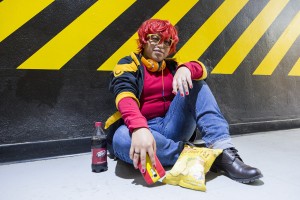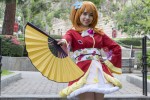Gunilla Leuterio cosplays at conventions, festivals and Trader Joe’s.
The fourth-year microbiology, immunology and molecular genetics student enjoys getting together with friends and randomly heading to the supermarket in costumes from different anime or manga series.
Leuterio says that people are often very confused when they see her wearing elaborate costumes of characters such as Yoosung from “Mystic Messenger,” a South Korean mobile game.
“At a convention, if you’re in cosplay, you feel a little like a celebrity,” Leuterio said. “But when you go to Ralphs and Trader Joe’s, it’s kind of like, ‘Are they okay?'”
Leuterio is a cosplayer, a person who dresses up as a character from popular media. Although the term has expanded to include fans of various movies, TV shows, comic books and video games, the term cosplay was originally coined in Japan by the magazine “My Anime” to describe fans dressed as characters from manga and anime. The practice is popular among fans of Japanese animation.
While student cosplayers face a variety of challenges such as designing costumes and contending with negative body images, their individual experiences vary greatly.
[Related: UCLA’s Fresh Produce draws student interest to art in manga, anime]
Some cosplayers buy their costumes online, while others make them from scratch. Fourth-year biology student Vivian Nguyen said it doesn’t matter where a costume comes from as long as the cosplayer is having fun. However, Nguyen said she loves the feeling of satisfaction that comes from making her own costumes.
The process of making a costume differs between cosplayers. Melody Murillo, a fourth-year sociology student, drafts her own patterns, using sketches to deconstruct individual design elements of each clothing item.
Nguyen approaches her cosplay from a research standpoint and searches for tutorials online to construct specific elements. For her latest cosplay, she made a corset for the first time for a Sailor Pluto costume based on “Sailor Moon” fan art. She used YouTube tutorials to find the right fabrics and to learn how to construct the garment.

In addition to their individual experiences with designing and creating costumes, cosplayers face a variety of issues.
For example, giving consent for photographs is a major issue in the cosplay community, Leuterio said. Many people take photos or put their arms around a cosplayer without asking first.
Leuterio was so used to people just putting their arms around her that when one man asked for permission, she was taken aback.
“Honestly, a lot of people think it’s okay to do things while talking to a cosplayer and really it shouldn’t be because some cosplayers are uncomfortable and some just think it’s rude,” she said.
Cosplayers also face preconceptions about appearance, said Karen Fields, fourth-year psychobiology student. She believes cosplay should focus on personalizing the cosplay, rather than looking exactly like the character, she said.
“Even if (cosplayers) don’t look like the character, they can make it their own and just cosplay it their own way (and) personalize it,” Fields said.
Murillo also found body image to be an issue for cosplayers, given the often-sexualized version of cosplay that many people encounter, she said.
“(You’ll) see cosplayers that are very thin or have a lot of boob and a lot of things going on where most people don’t,” Murillo said. “That discrepancy between what this completely fictional character looks like and what you look like … you have to bridge that gap and learn to be okay with it.”
Despite all the challenges that cosplayers face, cosplay is a form of escapism that allows them to take a break from everyday life by stepping into a new identity, Nguyen said. She said cosplaying as strong female characters helped her break out of her shell as an introvert.
“For photos, I’m supposed to look strong and commanding,” Nguyen said. “I sort of adapt all those characteristics from the characters I love into my everyday life, so now I’m more open to trying new things. I’m not as shy as before.”
Cosplaying with confidence didn’t come easily for Fields. However, when she performed with an anime dance group at FEAST at Rieber for Anime Dinner Night in May 2015, being in costume and embodying her character helped give her confidence to talk to random people without being shy, she said.
Leuterio’s most meaningful cosplay is the character Sailor Jupiter from the show “Sailor Moon.” Leuterio grew up watching “Sailor Moon” and related to the character because of their similar pasts – Sailor Jupiter’s parents died when she was a child and Leuterio lost her own father at a young age.
“When I watched ‘Sailor Moon,’ I would see Sailor Jupiter as kind of like an older sister that I want to emulate,” Leuterio said. “It means so much if you really love the character that you’re cosplaying – you just feel a surge of electricity come through you.”

Indeed, Confidence is one of the most important traits that could become delicately ideal for all of us that we think is good. Assignment Writing Services UK